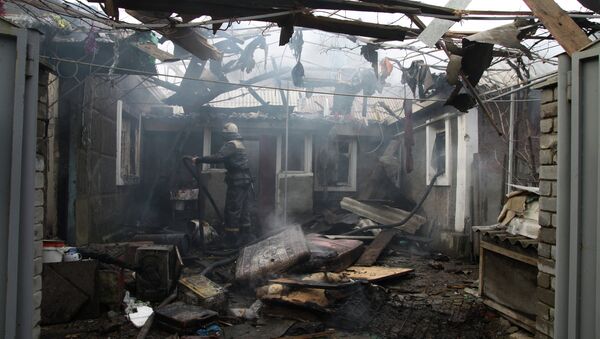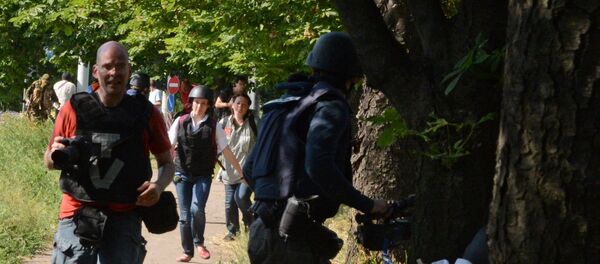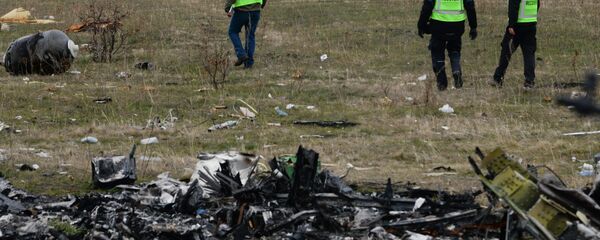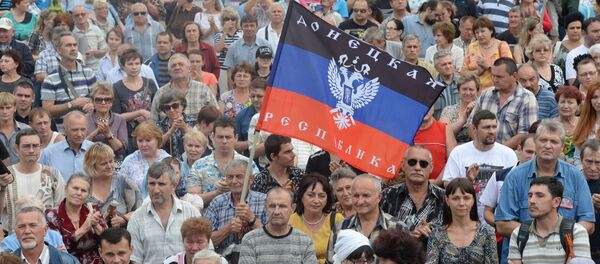On February 22, 2014, Ukraine's one-chamber Parliament, the Verkhovna Rada voted to impeach Yanukovych before announcing the next presidential election to be held on May 25. Oleksandr Turchynov was appointed Ukraine's acting president.
Some of the country's southeastern regions did not recognize the legitimacy of the new Kiev authorities. From March, supporters of the country's federalization started holding rallies in eastern Ukraine, specifically in Donetsk, Kharkiv and Lugansk, demanding referendums on the status of their regions. Then protests spread to several other cities in the Donetsk region, including Slaviansk, Mariupol, Yenakiyevo and Kramatorsk.
Protesters in Donetsk and Kharkiv seized regional administration buildings and in Lugansk they took control of the Ukrainian Security Service regional administration building.
On April 7, 2014, following the seizure of administrative buildings in Kharkiv, Donetsk and Lugansk, Acting President Oleksandr Turchynov announced the creation of an anti-crisis headquarters, while also saying that "anti-terrorist measures will be taken against those who have taken up arms."
On April 13, the Ukrainian National Security and Defense Council decided to launch a full-blown operation with the use of armed forces.
On April 14, Turchinov enacted the National Security and Defense Council's decision to take "emergency measures" to protect the country's territorial integrity.
On April 16, the First Reserve Battalion of the National Guard, which enrolled volunteers from the Maidan Self-Defense Force, was sent to the front line near Slaviansk, which was occupied by the Donbas People's Militia on April 12.
On May 2, an active phase of the special operation against the federalization supporters began in Slaviansk.
Igor Strelkov assumed the command of the armed forces of the self-proclaimed Donetsk People's Republic (DPR) and declared a "counterterrorist operation" regime.
On May 25, a snap presidential election was held in Ukraine. There were 21 candidates running for the presidency. The winner was Petro Poroshenko, with 54.7 percent of the vote.
On June 7, Petro Poroshenko was inaugurated as the president of Ukraine.
Within two weeks after Poroshenko's inauguration, combat operations in the Donetsk region spread from Slaviansk to the entire region, including Mariupol, Kramatorsk and Gorlovka.
Poroshenko vowed to finish the special operation shortly, and put forward a 15-point peace plan. The plan envisaged exemption from criminal liability for all those who would lay down their arms and had not committed serious crimes, as well as the release of hostages. The plan also envisioned steps toward the decentralization of government, protection of the Russian language and amending the Ukrainian Constitution.
Poroshenko ordered a week-long ceasefire for all law enforcement, defense and security units involved in the special operation in the east of the country.
The truce lasted 10 days. On July 1, Ukrainian security forces resumed the active phase of the special operation.
On July 4, Ukrainian security forces took control of several cities in the east of the country, including Slaviansk, Kramatorsk, Artyomovsk and Druzhkovka. The militia forces in the north of the Donetsk region retreated to Donetsk, Gorlovka and Snezhnoye.
In mid-July, in a bid to encircle the territory controlled by the self-defense forces (primarily Donetsk, Gorlovka, Makeyevka and Lugansk) and to cut it off from the Russian border, Ukrainian security forces established a 8-10 km "corridor" between the border and the militias. The offensive fell through due to fierce resistance from the militias. Several Ukrainian army units were encircled before running out of ammunition, food and water supplies.
In late July, after running out of ammunition and losing significant numbers of personnel, Ukrainian servicemen started crossing into Russian territory on a mass scale, fleeing militia fire. The biggest "exodus" came late on August 3, when a total of 438 Ukrainian servicemen asked Russian Border Guard Service for asylum.
Following the security forces" retreat from the border, the self-defense forces tightened their control over the border in the Donetsk and Lugansk regions.
In late August, Ukrainian battalions were encircles near Ilovaisk in the Donetsk region, including the headquarters of the Eighth Army Corps, the 28th, the 30th and the 93rd Motorized Infantry Brigades, the 95th Airmobile Brigade, the Aidar, Donbas, and Shakhtarsk territorial defense battalions, attached to them, and the National Guard Azov and Dnepr battalions.
After days of encirclement the government forces reached an agreement with independence supporters, which allowed them to retreat from the besieged town.
On September 5, with Russian and OSCE mediation, the Kiev authorities and the self-proclaimed DPR and LPR signed a ceasefire protocol. The sides also reached an agreement on the withdrawal of heavy weapons, prisoner exchange and humanitarian assistance.
The intensity of hostilities somewhat abated but fighting and attacks continued in certain sectors.
Starting from September, several rounds of talks were held in Minsk between the representatives of Ukraine and the self-proclaimed republics with OSCE and Russian mediation. The sides discussed a ceasefire and its monitoring by the OSCE, the withdrawal of heavy weapons from the line of demarcation between the security forces and the militias and the exchange of prisoners.
Moscow and the self-proclaimed republics repeatedly urged Kiev to comply with the Minsk agreements, providing for a ceasefire and the withdrawal of heavy weapons.
On February 12, the Normandy format talks on the Donbas settlement took place in Minsk with the participation of German, Russian, French and Ukrainian leaders. The consultations of the Trilateral Contact Group, including Russia, Ukraine and the OSCE, were held in the Belarusian capital.
Two documents were agreed during the marathon talks.
The talks produced two documents. The first was the Package of Measures to for the Implementation of the Minsk Agreement, which envisioned a ceasefire and the pullout of heavy artillery from the line of contact to create a 50-150 km security zone. The Agreement also called for a constitutional reform in Ukraine, including decentralization and granting special status to Lugansk and Donetsk.
The second document was a declaration in support of the Package of Measures for the Implementation of the Minsk Agreement, which was adopted by the Normandy Four leaders.
On February 17, the UN Security Council adopted a resolution in support of the Minsk Agreement to resolve the crisis in Ukraine.
Soon after the ceasefire was declared fighting resumed in Donbas, with the sides blaming each other and claiming they were only returning the fire. Kiev is pondering the possibility of asking the UN and the EU to deploy peacekeepers to Donbas.
More than 1.5 million people have been displaced.
According to President Poroshenko, 1,549 Ukrainian servicemen were killed during the special operation in Donbas, with 64 killed since February 15.
According to the Ukrainian authorities, over 14,000 militia members have been killed in the self-proclaimed republics.
According to the OSCE, since November 2013, seven reporters have been killed in Ukraine, including six in the east of the country, and at least 170 reporters have been injured.
The following Russian journalists were killed in southeastern Ukraine in the line of duty: Rossiya Segodnya's special photo correspondent Andrei Stenin, Channel 1 operator Anatoly Klyan, Rossiya TV network correspondent Igor Kornelyuk and sound engineer Anton Voloshin. All of them were posthumously awarded the Order of Courage in Russia.









